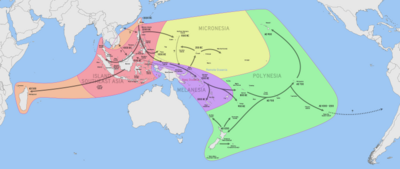
Back الحيوانات والنباتات المستأنسة في أسترونيزيا Arabic Plantas y animales domesticados de Austronesia Spanish Tumbuhan dan hewan terdomestikasi di Austronesia ID

One of the major human migration events was the maritime settlement of the islands of the Indo-Pacific by the Austronesian peoples, believed to have started from at least 5,500 to 4,000 BP (3500 to 2000 BCE). These migrations were accompanied by a set of domesticated, semi-domesticated, and commensal plants and animals transported via outrigger ships and catamarans that enabled early Austronesians to thrive in the islands of Maritime Southeast Asia (also known as 'Island Southeast Asia'. e.g.: Philippines, Indonesia), Near Oceania (Melanesia), Remote Oceania (Micronesia and Polynesia), Madagascar, and the Comoros Islands.[2][3]
They include crops and animals believed to have originated from the Hemudu and Majiabang cultures in the hypothetical pre-Austronesian homelands in mainland China,[4] as well as other plants and animals believed to have been first domesticated from within Taiwan, Maritime Southeast Asia, and New Guinea.[5][6] Some of these plants are sometimes also known as "canoe plants", especially in the context of the Polynesian migrations.[7][8][9] Domesticated animals and plants introduced during historic times are not included.
- ^ Chambers, Geoff (2013). "Genetics and the Origins of the Polynesians". eLS. John Wiley & Sons, Inc. doi:10.1002/9780470015902.a0020808.pub2. ISBN 978-0470016176.
- ^ Bellwood, Peter (2004). "The origins and dispersals of agricultural communities in Southeast Asia" (PDF). In Glover, Ian; Bellwood, Peter (eds.). Southeast Asia: From Prehistory to History. RoutledgeCurzon. pp. 21–40. ISBN 9780415297776.
- ^ Reilly, Kevin (2012). Volume I: Prehistory to 1450. The Human Journey: A Concise Introduction to World History. Vol. 1. Rowman & Littlefield Publishers, Inc. pp. 207–209. ISBN 9781442213869.
- ^ Liu, Li; Chen, Xingcan (2012). "Emergence of social inequality – The middle Neolithic (5000–3000 BC)". The Archaeology of China: From the Late Paleolithic to the Early Bronze Age. Cambridge World Archaeology. Cambridge University Press. p. 204. doi:10.1017/CBO9781139015301.007. ISBN 9780521644327.
- ^ Bourke, Richard Michael (2009). "History of agriculture in Papua New Guinea" (PDF). In Bourke, Richard Michael; Harwood, Tracy (eds.). Food and Agriculture in Papua New Guinea. ANU E Press. pp. 10–26. doi:10.22459/FAPNG.08.2009. ISBN 9781921536618.
- ^ Cite error: The named reference
Denham2011was invoked but never defined (see the help page). - ^ W. Arthur Whistler (1991). "Islands, Plants, and Polynesians—An Introduction to Polynesian Ethnobotany." National Tropical Botanical Garden c/o Botany Department University of Hawaii Honolulu, Hawaii 96822. Retrieved March 2022.
- ^ Kitalong, Ann Hillmann; Ballick, MichaelJ.; Rehuher, Faustina; Besebes, Meked; Hanser, Sholeh; Soaladaob, Kiblas; Ngirchobong, Gemma; Wasisang, Flora; Law, Wayne; Lee, Roberta; Tadeo, Van Ray; Kitalong, Clarence; Kitalong, Christopher (2011). "Plants, people and culture in the villages of Oikull and Ibobang, Republic of Palau". In Liston, Jolie; Clark, Geoffrey; Alexander, Dwight (eds.). Pacific Island Heritage: Archaeology, Identity & Community. Terra Australis. Vol. 35. ANU E Press. pp. 63–84. ISBN 9781921862489.
- ^ Theroux, Paul (December 2002). "The Hawaiians". National Geographic. 202 (6): 2–41.
© MMXXIII Rich X Search. We shall prevail. All rights reserved. Rich X Search